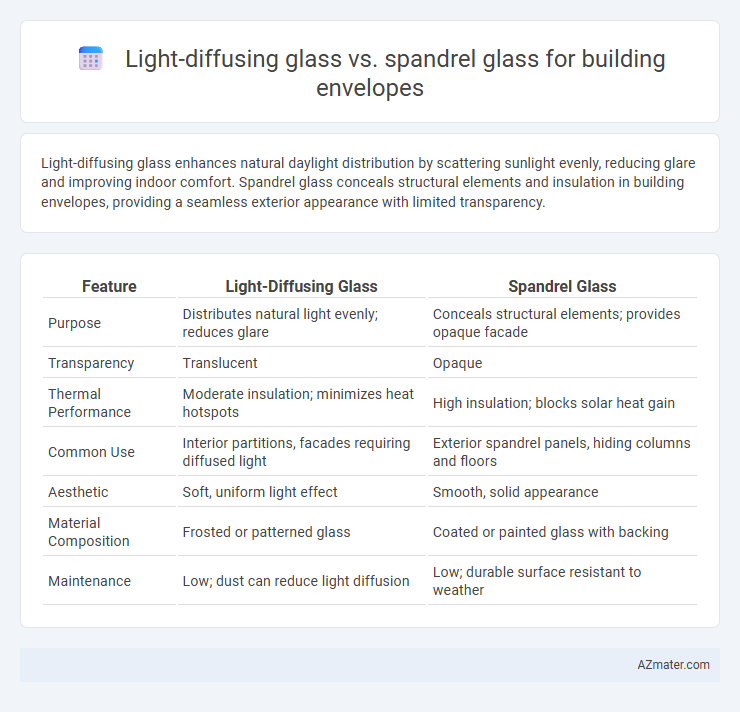Light-diffusing glass enhances natural daylight distribution by scattering sunlight evenly, reducing glare and improving indoor comfort. Spandrel glass conceals structural elements and insulation in building envelopes, providing a seamless exterior appearance with limited transparency.
Table of Comparison
| Feature | Light-Diffusing Glass | Spandrel Glass |
|---|---|---|
| Purpose | Distributes natural light evenly; reduces glare | Conceals structural elements; provides opaque facade |
| Transparency | Translucent | Opaque |
| Thermal Performance | Moderate insulation; minimizes heat hotspots | High insulation; blocks solar heat gain |
| Common Use | Interior partitions, facades requiring diffused light | Exterior spandrel panels, hiding columns and floors |
| Aesthetic | Soft, uniform light effect | Smooth, solid appearance |
| Material Composition | Frosted or patterned glass | Coated or painted glass with backing |
| Maintenance | Low; dust can reduce light diffusion | Low; durable surface resistant to weather |
Introduction to Light-Diffusing Glass and Spandrel Glass
Light-diffusing glass enhances building envelope performance by scattering natural light to reduce glare and improve interior illumination without compromising privacy. Spandrel glass serves as an opaque panel in curtain wall systems, concealing structural elements, insulation, or mechanical components while maintaining a consistent exterior appearance. Both materials optimize facade aesthetics and energy efficiency, but light-diffusing glass prioritizes daylight management, whereas spandrel glass focuses on architectural concealment and thermal insulation.
Defining Key Properties of Light-Diffusing Glass
Light-diffusing glass is engineered to scatter incoming light uniformly, reducing glare and enhancing indoor natural illumination while maintaining privacy. Its key properties include high translucency, controlled light transmission, and surface treatments or embedded particles that diffuse light without compromising structural integrity. Unlike spandrel glass, which is primarily used for concealing building elements and providing a reflective or opaque facade, light-diffusing glass optimizes daylight distribution within the building envelope.
Understanding Spandrel Glass: Features and Functions
Spandrel glass serves as an opaque building envelope component, concealing structural elements, insulation, and mechanical systems while maintaining a consistent architectural appearance. Its features include thermal insulation, fire resistance, and compatibility with adjacent vision glass, contributing to energy efficiency and aesthetic uniformity. Unlike light-diffusing glass, which allows natural light transmission and softens sunlight, spandrel glass prioritizes concealment and durability without light permeability.
Aesthetic Impact on Building Façades
Light-diffusing glass enhances building facades by softening natural light and creating uniform illumination, resulting in a visually appealing, glowing surface that minimizes glare and hotspots. Spandrel glass, often opaque or painted, conceals structural elements and mechanical systems, contributing to a sleek, monolithic appearance that complements curtain walls without sacrificing aesthetics. Both materials significantly influence facade design, with light-diffusing glass emphasizing luminosity and depth, while spandrel glass provides seamless opacity and architectural consistency.
Daylighting Performance: Managing Natural Light
Light-diffusing glass enhances daylighting performance by scattering sunlight evenly, reducing glare and minimizing harsh shadows within building interiors. Spandrel glass, typically opaque or reflective, blocks direct natural light, serving primarily for aesthetic concealment and insulation rather than daylight penetration. Effective building envelope design integrates light-diffusing glass in vision areas to optimize natural light distribution while using spandrel glass in spandrel panels to maintain energy efficiency and conceal structural elements.
Energy Efficiency Considerations
Light-diffusing glass enhances energy efficiency by evenly distributing natural daylight, reducing the need for artificial lighting and minimizing glare, which lowers energy consumption in buildings. Spandrel glass, typically used to conceal structural elements and insulation, offers superior thermal insulation, contributing to improved building envelope performance and reduced heating and cooling loads. Selecting the appropriate glass type depends on balancing daylight optimization with thermal insulation requirements to maximize overall energy efficiency.
Privacy and Visual Obstruction
Light-diffusing glass enhances privacy by scattering transmitted light, preventing clear visibility while maintaining natural daylight inside buildings. Spandrel glass provides complete visual obstruction by concealing structural elements and mechanical equipment, ensuring external uniformity and privacy without transparency. Both materials are essential in building envelopes where controlled visibility and aesthetic consistency are critical.
Installation and Maintenance Differences
Light-diffusing glass requires precise installation to ensure uniform light distribution and minimize glare, often involving specialized framing systems to maintain its optical properties. Maintenance involves regular cleaning with non-abrasive materials to preserve its diffusion surface and prevent scratches that could impair light transmission. In contrast, Spandrel glass installation focuses on concealing building elements and providing a uniform exterior appearance, typically using standard curtain wall framing, with maintenance centered on cleaning and occasional resealing to prevent water infiltration and maintain aesthetics.
Cost Analysis: Light-Diffusing vs Spandrel Glass
Light-diffusing glass typically incurs higher upfront costs due to advanced manufacturing processes that enhance natural light distribution within building envelopes, while spandrel glass is generally more cost-effective as it serves primarily a non-vision decorative function covering structural elements. The long-term energy savings of light-diffusing glass through improved daylight penetration can offset initial expenses, though spandrel glass may reduce costs related to maintenance and replacement due to its simplicity and durability. Budget considerations for building envelopes often weigh the enhanced occupant comfort and potential energy benefits of light-diffusing glass against the straightforward, economical application of spandrel glass in areas where visibility is not required.
Choosing the Right Glass for Your Building Envelope
Light-diffusing glass enhances natural daylight distribution inside buildings, reducing glare and improving occupant comfort, making it ideal for spaces requiring uniform light without compromising privacy. Spandrel glass conceals building components such as structural elements and insulation while maintaining the facade's aesthetic continuity, often used in curtain walls and storefronts. Selecting the right glass depends on balancing visual performance, energy efficiency, and design requirements to optimize both the building envelope's functionality and architectural appeal.

Infographic: Light-diffusing glass vs Spandrel glass for Building envelope
 azmater.com
azmater.com